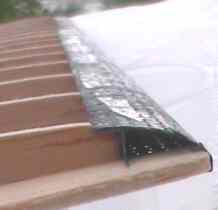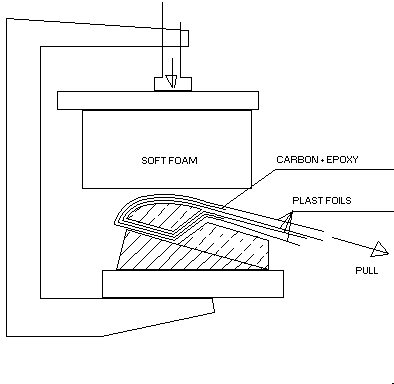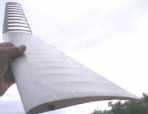|
CARBON D-BOX When we make a good wing with D-box we use carbon and/or kevlar fabric cut in 45 degrees (tape on edges to keep the shape) for D-box surface, ribs inside the D-box, unidirectional carbon spars and balsa, carbon fabric or similar between those spars and some kevlar thread to bind the spars together.  When I make a reasonable wakefield wing with D-box I take a piece of carbon fabric 190 g/m2 cut it in 90 degrees and without any tapes on edges. And that's all. The longitudinal fibers are instead of spars, the across fibers instead of ribs and spar webbing. All together they take the torque, not as well as fibers in 45 degrees but good enough. Better than those balsa D-box wings we used to fly only a few years ago, do you remember? When I make a reasonable wakefield wing with D-box I take a piece of carbon fabric 190 g/m2 cut it in 90 degrees and without any tapes on edges. And that's all. The longitudinal fibers are instead of spars, the across fibers instead of ribs and spar webbing. All together they take the torque, not as well as fibers in 45 degrees but good enough. Better than those balsa D-box wings we used to fly only a few years ago, do you remember?
I have an inside mold made of wood and an outside half mold for lower side of D-box. (see drawing). First I carve and grind the section of D-box about 50 mm wide of hard wood. Then I saw the final D-box width and glue the rest back part on the plate to make the lower part of mold. The rear end of D-box is tilted to make the box lighter and to give more area to clue the ribs. Instead of he upper side of D-box outside mold there is some soft foam. 
When making a D-box I cut two pieces of plastic foil, about 10 cm wide. Thinner plastic goes a little "into" the carbon fabric between the threads and pushes some resin out. If I want smooth surface I use thicker plastic (0.3 mm). Then the D-box is a little heavier.  Next I cut carbon fabric, some 10 mm wider than the circumference of D-box, put it on one plastic foil (laying on desk) and apply epoxy, thinned with methanol. Let methanol fibers some 10 minutes, put the other plastic on carbon and wrap all that around the inside D-box mold. The other plastic foil is now between carbon and inside mold, the firs one between carbon and outside mold and foam. The rear end of D-box is 'open'; plastic foils between the upper and lower carbon laminate. That makes releasing the D-box easy. Next I cut carbon fabric, some 10 mm wider than the circumference of D-box, put it on one plastic foil (laying on desk) and apply epoxy, thinned with methanol. Let methanol fibers some 10 minutes, put the other plastic on carbon and wrap all that around the inside D-box mold. The other plastic foil is now between carbon and inside mold, the firs one between carbon and outside mold and foam. The rear end of D-box is 'open'; plastic foils between the upper and lower carbon laminate. That makes releasing the D-box easy.
Then I press all that with clamps between lower mold and foam pulling the plastic foils backwards tight, no wrinkles, no loose foil or carbon fabric at the leading edge. When cured (next day) I open the mold. I pull the D-box out of the inside mold, and remove the plastic foils. I cut the rear end of D-box to the final width. I glue syano or the D-box rear end to make a tube either now or when putting together the wing and twisting the final warps. My D-box mold is according to my thinnest section. I can make little thicker wings, too, with the same mold, by putting up to 2 mm hard balsa, hard wood or carbon between upper and lover laminate at the rear end. PS: That story was written last summer (-95) for Adrian Bryant and FF Down Under. It came out in september and soon there were many wings using this method under construction in Australia. I made two wings like this last year and two wings using one layer carbon 190 g/m2 in 45 degrees and some carbon roving to make "spars". The 1.65 m long wing was 40 grams before cowering and very rigid.  In my club we have made F1A-wings with this method, too. Then the rear end of D-box is vertical to take more bending forces and we use one layer 190 g carbon in 45 degrees and unidirectional russian carbon as much as we used to put in spars. Now the "spars" are spread over the area of D-box, perhaps a little more at the rear end, and laminated together with D-box. In my club we have made F1A-wings with this method, too. Then the rear end of D-box is vertical to take more bending forces and we use one layer 190 g carbon in 45 degrees and unidirectional russian carbon as much as we used to put in spars. Now the "spars" are spread over the area of D-box, perhaps a little more at the rear end, and laminated together with D-box.
Try your own materials, but the method is easy and fast. The fastest to make a wing with ribs? To make a mold takes only a couple of hours. written by Ossi Kilpeläinen |

